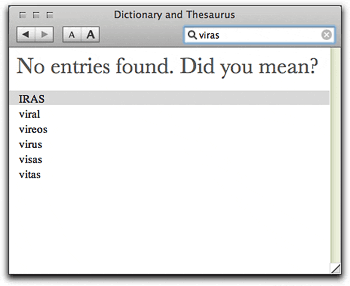2. A Freakin’ Awesome Dictionary
I’ll bet those of you who read my first article in this series last spring are either Windows fans who have been chuckling, “See, he could only think of one thing!” Or you’re Mac fans who are disappointed that I started in strong to give the other side “what for,” but then left the match just when it was getting interesting.
Although you’d both be wrong, you have to understand that here on Mars, time moves at a somewhat slower pace than it does on Earth. You see, here it’s only been a month since I wrote that first installment, and I thought I was doing pretty good to be getting a second one in already. Then I realized how it might look from down here, and, well… I’ll try to get the third article done in a time frame that will make more sense to you folks.
Now, you ask, “Exactly how could something as mundane as a dictionary possibly induce envy in a Windows user?” Ah, I see you’re one of those who still hasn’t fully appreciated the awesome Dictionary.app built into Tiger (Mac OS X 10.4). It’s already been highlighted in all the Mac news magazines, glorified in all the Mac blogs, and praised endlessly in the Mac discussion forums. Yet I still encounter good, hardworking Mac users who don’t know about it yet. How could that be?
Well for one thing, the Tiger Dictionary ain’t exactly a flashy product. It doesn’t sit in your Dock, so it’s easy to miss. I don’t think Steve included it in any of his Tiger demos. On its website, Apple doesn’t do anything more than mention the Dictionary as one of Tiger’s 200+ new features. And, well, it’s just a Dictionary, after all.
You know, one of things I admire most about Apple is the way they nourish creative programmers who come up with crazy ideas that may or may not work out. Rather than forcing these guys (and gals) to prepare Business Cases for their ideas–as so many companies do–they actually allow them to flesh the ideas out into slick, ingenious new features of the operating system. Many of these features, like the Tiger Dictionary, bring to life functionality that no user was clamoring for, but that quickly becomes such an obvious improvement that you can’t imagine a Mac without it.
In a future article in this series, I’ll talk a bit more about a related technology that fits this mold–namely, application “Services.” With services, Apple’s engineers provided not just one little application, but rather an entire new software foundation upon which users and developers could build beautiful, intricate software playgrounds and tools. The Dictionary is, in fact, a specialized application service that’s been added to Mac OS X.
This is a pretty big buildup, fella. You better go ahead and get specific with the Dictionary hoopla, or I’m outta here!
OK, I hear you… On with the shew!
Imagine this scenario. You’re a Windows user (hey, stay with me for a minute on this! You only have to use Windows hypothetically, and only for a few minutes), cruising along in Internet Explorer (stay with me!), and you encounter a word you don’t precisely understand. For example, “registry.”
At this point, you have two options (without resorting to third-party software):
- You interrupt what you’re doing and open a new browser window to load dictionary.com (or one of many others). There, you type in (or, if you’re a geek, you cut/paste) your word and hit return. Back comes your definitions! In the old days, we thought this was pretty spiffy, because it sure beat option
- You can get up and hunt through all the bookshelves in the house for that dictionary you used to keep around for the kids to use, instead of Mom or Dad’s brain, to look up new words. If you can’t find the portable one, you can go leafing through the Webster’s Third International monster on its pedestal in the living room, which means making a trip back to your desk to retrieve your reading glasses since the monster has such teeny tiny type. (By the way, did Webster ever come out with a Fourth International? Hmmm…)
Incidentally, get a load of the irrelevant drivel I had to endure while looking up “registry” in the Internet dictionary:
Or perhaps you think that’s entertaining. Sorry! I didn’t mean to insult your obvious good taste by calling it drivel. ;-] Now that I’ve found my definition, I’m in a separate window, of course (IE still doesn’t support tabs!) and must make my way back to the window I started from. At which point I no longer have my definition before me… But that’s what the clipboard is for, right?
So, I can hear you saying, “What’s so bad about option 1?” To which I reply, “Well, I never said option 1 was bad… I was happy with it myself until Tiger was released earlier this year. However, just as option 2 has been mostly superceded nowadays by option 1, option 1 has now been superceded on the Mac by something better!”
How much better? Well, imagine you’re an Apple user running Tiger, and you encounter an unknown word… like, oh, how about “Adware”? Well now all you have to do is highlight the word, press a couple of keys or click your mouse, and Boom! The definition will materialize right over your mystery word. No more having to leave your current application or document, no more cutting/pasting to enter your word in the dictionary, and no more having to return to where you started while trying to remember the definition you ventured forth to find. [If you can play QuickTime movies, you're welcome to view the accompanying narrated screencast, which is provided in reduced-size h264 format (1.2mb) or in full-size h264 (3.5mb) or reduced-size mpeg4 (3.4mb).]
To get there in Tiger, you just select the word or phrase you want to define (on a Mac, this means just doubleclick the word) and use the contextual menu to select “Look Up In Dictionary.” This auto-magically pops up a small frame with the definition. If you want to load the full Dictionary application, click on the small “more” link in the lower right-hand corner of the panel. The full Dictionary window gives you some very cool ways to explore further, and I’ll get back to those in a moment.
By the way, roughly 90% of computer owners on this planet would never have to look up words like “Adware” and “Spyware,” I’m sure. But give us poor Mac nuts a break… We still don’t really understand what you’re going through. In fact, this whole page I used as an example is filled with words that simply don’t make sense when you’re talking about a computer–from a Mac perspective, that is:
- Spyware
- Virus
- Trojans (Gee, I thought I knew what those were… but for a computer?)
- Malformed
- Vulnerability
- Tracking threats
- Worms
But I digress…
Another neat feature of the little popup dictionary panel is the built-in Thesaurus. You can toggle between the Dictionary and Thesaurus information for each word you look up.
When you load the full Dictionary window for a word or phrase, you discover a totally new take on hypertext. Imagine a book where every word is a link to its definition, and you get some idea of what the Dictionary is like. To follow the trail of a word, just click on any interesting word on the page.
This is going to be huge for anyone still going to school or college! And what a relief for parents of young kids, too. Anything that makes looking up words in the dictionary easier brings them a step closer to actual learning, and a step away from laziness. In my experience, even the Internet has been too many steps for my sons to bother with, when they can always shout out to old Dad,
Hey Dad! What’s “enlightenment”?
So when you’ve embarked on a word-hunt in Apple’s Dictionary, you pretty soon find yourself a long way from where you started. And just like a web browser, the Dictionary’s back button provides a navigation trail. Hold the back button down to see the full list of all the words you’ve seen. For example, in my screencast that accompanies this article, I started with “Malformed” and ended up with “Malevolent.” I don’t know why Microsoft words like “Adware” and “Virus” automatically beat a path to words like “Malevolent,” but they always seem to. ![]()
By the way, you can also use the Dictionary on phrases. Just select the phrase and “Look Up In Dictionary” to see what it means. If you’re a keyboard kind of person, you’ll be happy to hear that there’s a built-in keyboard shortcut for this. Just hover the mouse over a word and select Ctrl-Cmd-D to see its definition.
 Did I mention that the Dictionary can also guess at a misspelled word? For example, when I first mis-typed “virus” into the Dictionary search field, here’s what it helpfully provided —»
Did I mention that the Dictionary can also guess at a misspelled word? For example, when I first mis-typed “virus” into the Dictionary search field, here’s what it helpfully provided —»
Oh, and on a Mac, if you want to hear a word spoken, you can use another built-in software service, “Speech.” Just select the word and mouse to “Services/Speech/Start Speaking Text.” Like the Dictionary, the Speech service is available in all service-aware Macintosh applications. The Mac’s software services are a hard-working, invisibly wonderful part of the Mac experience nowadays. Along with the new Dictionary, they expand our understanding of what’s possible on a computer, providing one more way to make our interaction with them easier, more rewarding, and more fun.
I know it’s hard to imagine, but yes, the Apple Dictionary is actually fun to use! Perhaps one day Windows users will see such a feature built into their chosen operating system.* But for quite a while, I suspect, it’s one of the many things I can do with a Mac that simply aren’t possible on a Windows PC.












